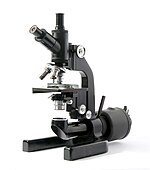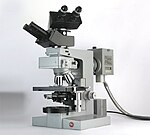Leitz Ortholux
With the Leitz-Ortholux , a microscope was constructed in 1935 that at that time brought many of the features of a modern microscope that are taken for granted today. The first copies were delivered in 1936 as "MX" (microscope X). The device did not yet have its own name.
features
The Leitz-Ortholux had built-in lighting that - once adjusted - followed the Koehler principle and thus enabled ergonomic work. In order to achieve this, the microscope stand was rotated by 180 °. The lighting was therefore on the side facing away from the viewer. This also had the advantage that the view of the specimen was free and not hindered by the tripod as was previously the case.
Designed from the outset as a modular system, the Ortholux could be equipped for all light microscopy methods known at the time. A cast aluminum tripod with a three-point base provided the necessary stability.
A special version, which was only equipped for reflected light microscopy, was offered as "Metallux". The microscopy of metal cuts and ores was the main application of incident light microscopy at that time, hence the name.
With early Metalluxes, the transmitted light openings were not even milled out. Later (from approx. 1962) conventional Ortholuxe microscopes were used as Metallux microscopes, the transmitted light openings of which were closed with lids.
history
From 1935 on, the Leitz-Ortholux was built almost unchanged for almost 40 years. The design principle was a modular system. This made it possible over the years to keep pace with current developments in microscopy, optics and research, or to integrate them. The large “ Panphot ” photomicroscope was presented as early as 1933 . The "Monocular-Binocular Laboratory Microscope" (MBLM) appeared a year earlier and can be seen as the real pioneer of Ortholux. It was the world's first microscope with built-in lighting. All three use the same dovetail guide for tube mounting as the universal microscope and stands A and B before.
In the first 15 years there were hardly any changes to the tripod. Only the mold of the aluminum tripod was somewhat slimmed down internally at the end of the 1940s. You can't see it from the outside.
In 1952 the "preparation microscope" was created, a first approach to realize incident and transmitted light separately.
In 1953 the Ortholux received a newly designed tripod. The arm was narrower and the drive housing a little smaller. This created more free space to be able to attach appropriate incident light accessories. The fluorescent opaque according to Ploem can, for. B. cannot be mounted on older models. But there was still a switchable beam path for incident and transmitted light.
In 1959, the two lighting paths for incident and transmitted light were separated. Now it was possible to use both types of lighting in combination. This was useful for B. when combining reflected-light fluorescence with transmitted-light methods, such as dark field or phase contrast.
Another step was the move away from the two-diaphragm condenser to Berek in 1963 and the introduction of the 600 series system condensers. Now a field diaphragm was required in the tripod, which found its place between the folding lens and the mirror case.
The last, only externally serious change came in 1970. The Ortholux tripod received the then contemporary hammer finish paint, while all other components remained black.
Ortholux II
The Ortholux II, built from 1972 until the 1980s, continued the philosophy of a universally applicable and modularly expandable microscope.
In addition to its contemporary, angular, functional design, the Ortholux II was characterized by the following innovations:
- The nosepiece can be pulled out towards the front
- New series of plan-apochromatically corrected objectives
- Stronger light sources with halogen lamps
Like the Ortholux I, the Ortholux II was also available as a Metallux II. However, the tripod did not differ from the Ortholux II. Like this, it was also equipped with all transmitted light components. There were also two Pol versions: Ortholux II POL MK, without Bertrand lens and Ortholux II POL BK with Bertrand lens. These two stands differ from the standard stand in that they have a 35 mm × 12 mm filter slot for the rotatable analyzer (20 mm × 4 mm for the standard stand).
Earlier Ortholux II microscopes were given a gray hammer finish, the later ones with white.
Most of the components were compatible with the Diavert inverted microscope sold at the same time . This applied to objective nosepiece, observation tubes, condensers and lighting.
Some newly created components have also been provided with the old holder for the Ortholux I and can therefore also be used on older devices (reflected-light darkfield illuminator for HD lenses, reflected-light brightfield illuminator). Others were taken over by Ortholux I, such as B. the fluorescence illuminator according to Ploem.
Web links
- Leica Microsystems - Official website of the manufacturer
- Micscape Magazine - Ortholux II and Orthoplan, Portrait and Comparison
- Micro-Forum - The Leitz MBLM, portrait in the German-language "Micro-Forum"
- www.leitz-ortholux.de - history, web catalog with a large number of available components
- Leitz Ortholux II - well illustrated representation










